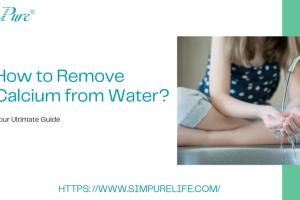Effective Strategies for Removing Calcium from Water: A Comprehensive Guide

-
Quick Links:
- 1. Introduction
- 2. Understanding Calcium in Water
- 3. Health Impacts of Calcium in Water
- 4. Methods to Remove Calcium from Water
- 5. Case Studies and Real-world Examples
- 6. Expert Insights on Water Treatment
- 7. Conclusion
- 8. FAQs
1. Introduction
Water is essential for life, but the quality of the water we consume can significantly impact our health and well-being. One of the most common issues faced by homeowners is high calcium content in water, often referred to as hard water. This comprehensive guide will delve into the reasons behind calcium presence in water, its impacts, and effective strategies to remove it.
2. Understanding Calcium in Water
Calcium is a naturally occurring mineral found in many water sources. It usually enters the water supply through the dissolution of rocks and soil, particularly limestone and gypsum. While calcium is essential for human health, excessive amounts can lead to various problems.
2.1 What is Hard Water?
Hard water is water that contains high levels of dissolved minerals, primarily calcium and magnesium. The hardness of water is often classified into two categories: temporary and permanent hardness.
- Temporary Hardness: Caused by bicarbonate minerals that can be removed by boiling.
- Permanent Hardness: Caused by sulfate or chloride compounds that cannot be removed by boiling.
3. Health Impacts of Calcium in Water
While calcium is necessary for health, excessive consumption can lead to health issues such as kidney stones and cardiovascular problems. It's important to maintain a balance in calcium intake from water and food.
3.1 Symptoms of Excessive Calcium
- Kidney stones
- Digestive issues
- Cardiovascular problems
4. Methods to Remove Calcium from Water
There are several methods to remove calcium from water, each with its pros and cons. Understanding these methods will help you choose the best one for your household needs.
4.1 Water Softening
Water softeners are devices that remove calcium and magnesium ions from water, replacing them with sodium or potassium ions. This process is known as ion exchange.
4.1.1 Types of Water Softeners
- Salt-based Softeners: Use sodium ions to replace calcium and magnesium.
- Salt-free Softeners: Use a different method, such as template-assisted crystallization, to prevent mineral buildup.
4.2 Reverse Osmosis
Reverse osmosis (RO) systems are effective in removing calcium and other contaminants from water. They work by forcing water through a semi-permeable membrane, allowing only water molecules to pass while blocking larger molecules.
4.3 Distillation
Distillation involves boiling water to create steam, which is then condensed back into liquid form. This method effectively removes calcium along with other impurities.
4.4 Chemical Treatment
Chemical treatments involve adding agents that react with calcium, making it easier to remove. Common chemicals used include sodium carbonate and citric acid.
5. Case Studies and Real-world Examples
Let's look at some case studies that highlight the effectiveness of different calcium removal methods.
5.1 Case Study: Residential Water Softening
In a suburban neighborhood with hard water issues, a family installed a salt-based water softener. Over six months, they reported a significant reduction in scale buildup on fixtures and improved soap efficiency.
5.2 Case Study: Reverse Osmosis System
A small restaurant opted for a reverse osmosis system to improve the quality of their food and beverages. They noticed a remarkable enhancement in taste and a decrease in maintenance costs for kitchen appliances.
6. Expert Insights on Water Treatment
We interviewed water treatment experts to gather insights on the best practices for calcium removal. Here are some key takeaways:
- Regular testing of water quality is crucial for identifying hardness levels.
- Combining different methods can yield the best results for households with varying needs.
- Investing in quality filtration systems can save money in the long run by reducing appliance wear and tear.
7. Conclusion
Removing calcium from water is essential for maintaining health, enhancing appliance longevity, and improving overall water quality. By understanding the various methods available and their effectiveness, you can make informed decisions tailored to your needs. Remember to regularly test your water and consider consulting with professionals for the best results.
8. FAQs
1. What is the best method to remove calcium from water?
The best method depends on your water quality and budget. Water softeners and reverse osmosis systems are popular choices.
2. Can boiling water remove calcium?
Boiling water can remove temporary hardness but is ineffective against permanent hardness.
3. Is hard water safe to drink?
Yes, hard water is generally safe to drink, but excessive calcium can lead to health issues.
4. How often should I test my water for hardness?
It’s advisable to test your water at least once a year or after any significant changes in water supply.
5. Can water softeners affect my health?
Water softeners can increase sodium levels in your water, which may affect individuals on sodium-restricted diets.
6. What is the cost of installing a water softener?
The cost can vary widely, ranging from a few hundred to several thousand dollars, depending on the system and installation.
7. Are there any eco-friendly options for calcium removal?
Salt-free water softeners and certain chemical treatments can be more environmentally friendly options.
8. How long do water softeners last?
With proper maintenance, water softeners can last 10-15 years.
9. What should I do if my water is still hard after treatment?
If your water remains hard, consider combining treatment methods or consulting a water quality expert.
10. Can I use household products to soften water?
Some household products, like baking soda and vinegar, can help reduce hardness temporarily but are not a long-term solution.